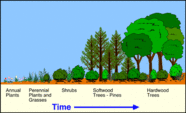- Southampton Middle School
- Effects of Change (L.S. 11)
Edwards, Stephen (Grade 8 Physical Science Teacher)
Page Navigation
-
Effects of Change Key Concepts

• Organisms may exist as members of a population; populations interact with other populations in a community; and communities together with the physical environment form ecosystems.
• Changes that affect organisms over time may be daily, seasonal, or long-term.
• Plants may respond to light by growing toward it or away from it, a behavior known as phototropism .
• Animals may respond to cold conditions with a period of lowered metabolism, a behavior know as hibernation .
• Organisms may respond to adverse conditions with a period of lowered or suspended metabolism, a behavior known as dormancy .• A variety o f environmental factors may cause the size of a population to increase or decrease. (This requires students to brainstorm examples of factors and predict the possible effects.)
• Large-scale changes may affect entire communities and ecosystems. • Such large-scale changes include the addition of excess nutrients to the system ( eutrophication ), which alters environmental balance; dramatic changes in climate ; and catastrophic events, such as fire, drought, flood, and earthquakes.

